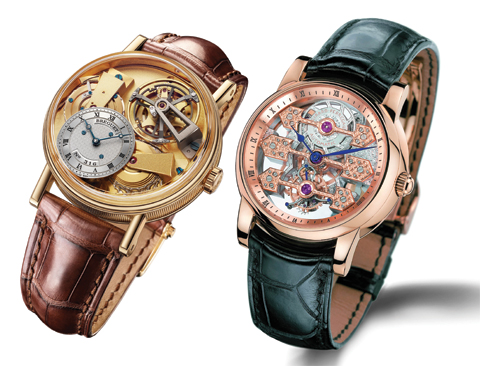Timeless: The patented tourbillon

Invented in 1795 by French watchmaker Abraham-Louis Breguet, the patented tourbillon is considered to be one of the most challenging watch mechanisms to craft and is highly valued for its design and delicate engineering. Originally an attempt to improve time accuracy, a tourbillon is a tiny device that was built to counter the effects of gravity. By mounting the escapement and balance wheel of the watch in a rotating cage, the effects of gravity are negated when the timepiece is rotated. In today’s modern world, a tourbillon is not required to produce a highly accurate timepiece. Nevertheless, the tourbillon is still one of the most revered features among watch enthusiasts. High-quality tourbillon wristwatches rank among the most expensive and sought after watches in the world.
[highlight_text] In order to display the beautiful arrangement on the front, Girard-Perregaux reversed the movement of the traditional design, resulting in the unconventional arrangement of the hour hand on top of the minute hand. [/highlight_text]
The Breguet Tradition 7047 Tourbillon Fusee is daring in its vibrant and complicated design. Inspired by the legendary Souscription watches of A.L. Breguet, the 7047 Tourbillon reveals one of the rarest horological complications-the chain and fusee. While being extremely difficult to manufacture the remarkably intricate fusee chain is implemented to ensure a constant delivery of power to the movement of the watch. The fusee chain, which looks like a miniature bike chain, can be seen delicately peeking out from the gear train, a characteristic unique to this watch alone.
The unmistakable 18-karat yellow gold timepiece possesses a considerable but fashionably large, eye-catching profile, due to the dramatic curve in its sapphire crystal. The watch’s splendor can be attributed to an off-center hand-engraved silver-gold dial on a rose engine. The tourbillon cage balance wheel and the bridge are both made out of titanium and sit opposite the dial, giving the watch warmth and balance. A power-reserve indicator on the barrel drum gauges the hand-wound movement of the watch.
Priced at $158,550, the Breguet Tradition 7047 Tourbillon Fusee isn’t just another tourbillon. Made to insurmountable standards, the Breguet timepiece redefines the boundaries of fine mechanics and will forever be coveted by watch collectors and enthusiasts throughout time.
First conceived in 1867, the Tourbillon with Three Gold Bridges by Girard-Perregaux is a breathtaking example of engineering perfection. The watch can be characterized by the purity of its beautifully functioning design. The watch is made up of a hybrid of ancient and modern elements giving it balance and unmovable stability.
The design of the Three Gold Bridges is said to be inspired by the Holy Trinity. From top to bottom the three bridges represent the Father, Son, and the Holy Spirit, respectively. Extremely fine engravings texture both sides of the gold bridges, which are held in place by brilliantly polished countersunk screws. The mechanics of the watch are smartly decorated by 30 jewels and are protected by a sapphire crystal.
In traditional design, the tourbillon escapement and bridges were located at the back of the timepiece. In order to display the beautiful arrangement on the front, Girard-Perregaux reversed the movement of the traditional design, resulting in the unconventional arrangement of the hour hand on top of the minute hand. The movement is not only a technical component of the watch, but also enhances its aesthetic appearance, to the point of being a mark of recognition. Priced at $145,000, the Skeleton Tourbillon with Three Gold Bridges is a remarkable example of possibly the most stunning decoration ever found on a wristwatch movement.












